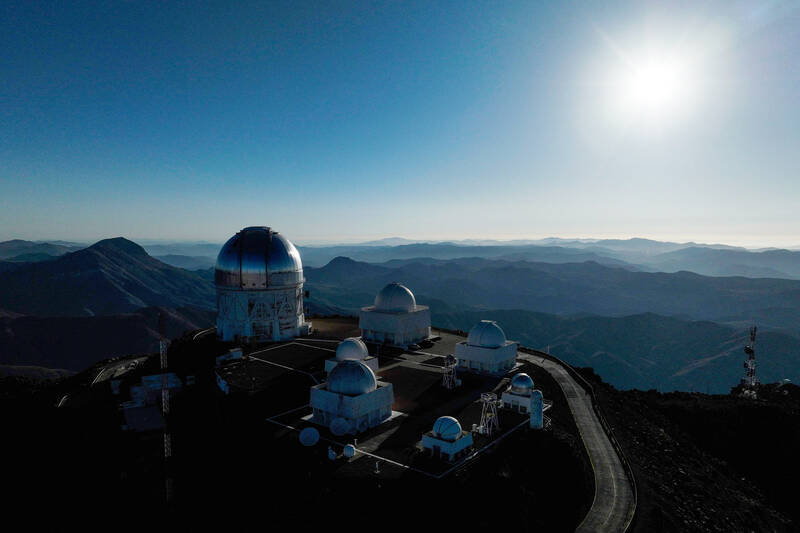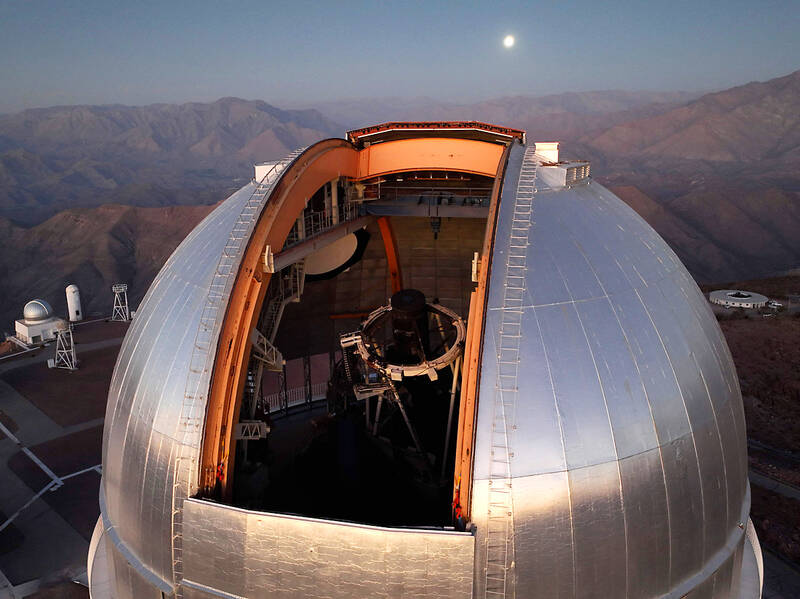Surrounded by the desert mountains and clear blue sky of northern Chile, astronomers from the Vera C. Rubin Observatory hope to revolutionize the study of the universe by affixing the world’s largest-ever digital camera to a telescope.
The size of a small car and weighing 2.8 metric tons, the sophisticated piece of equipment will reveal views of the cosmos as never before, officials from the US-funded project said. Beginning early next year, when the US$800 million camera will snap its first photos, the machine will sweep the sky every three days, allowing scientists to reach new heights in their galactic analyses.
Researchers will be able to go from “studying one star and knowing everything in-depth about that one star, to studying thousands of stars at a time,” said Bruno Dias, president of the Chilean Society of Astronomy (Sochias). According to Stuartt Corder, deputy director of NOIRLab, the US research center running the observatory located 2,500 meters up the Cerro Pachon mountain, 560 kilometers north of Santiago, the new facility will usher in “a paradigm shift in astronomy.”

Photo: AFP
The project solidifies Chile’s dominant position in astronomical observation, as the South American country is home to a third of the globe’s most powerful telescopes, according to Sochias, and boasts among the clearest skies on the planet. The Rubin Observatory camera’s first task will be to complete a 10-year review of the sky, called the Legacy Survey of Space and Time (LSST), which researchers hope will reveal information about 20 million galaxies, 17 billion stars and six million space objects. The survey will give scientists an up-to-date inventory of images of the solar system, allow them to map our own galaxy, the Milky Way and delve deeper into the study of energy and dark matter.
300TVs FOR ONE PICTURE
The new camera will be able to capture 3,200-megapixel photos — resulting in images so large they would require more than 300 average-size high-definition televisions, lined up together, to view just one. The machine, built in California, will have triple the capacity of the world’s current most powerful camera, the 870-megapixel Hyper Suprime-Cam in Japan, and will have six times the capacity of NOIRLab’s most powerful camera. The lab’s existing top camera, on Chile’s Cerro Tololo mountain, is only 520 megapixels, according to Jacques Sebag, head of construction of the Rubin telescope. Chile’s telescopes have come a long way since the 40-centimeter Cerro Tololo telescope, at the country’s first international observatory, installed in the 1960s.

Photo: AFP
“That telescope arrived here on the back of a mule, because there was no road,” said Stephen Heathcote, director of the Cerro Tololo Inter-American Observatory, only 20 kilometers from Cerro Pachon.
ASTRONOMY CAPITAL OF THE WORLD
The Vera C. Rubin Observatory, named in honor of the US astronomer who discovered dark matter, will join several other space observation research centers in northern Chile.

Photo: AFP
The natural conditions of the region’s desert landscape — tucked between the Pacific Ocean and the Andes mountain range — creates the clearest skies on the planet, thanks to a dry climate with little cloud cover. The area plays host to telescopes from more than 30 countries, including some of the most powerful astronomical instruments in the world, such as the radio telescope at the ALMA Observatory and the under-construction Extremely Large Telescope, which by 2027 is set to be able to view never-before-seen reaches of the universe.
Many of humanity’s most important astronomical discoveries have been made at the Cerro Tololo observatory, such as the 2011 Nobel Prize-winning revelation that expansion of the universe is picking up speed, a phenomenon known as cosmic acceleration. Though other influential observatories have been opened around the globe, including in the United States, Australia, China and Spain, “Chile is unbeatable” in the world of astronomy, said Dias, the Sochias president.

On April 26, The Lancet published a letter from two doctors at Taichung-based China Medical University Hospital (CMUH) warning that “Taiwan’s Health Care System is on the Brink of Collapse.” The authors said that “Years of policy inaction and mismanagement of resources have led to the National Health Insurance system operating under unsustainable conditions.” The pushback was immediate. Errors in the paper were quickly identified and publicized, to discredit the authors (the hospital apologized). CNA reported that CMUH said the letter described Taiwan in 2021 as having 62 nurses per 10,000 people, when the correct number was 78 nurses per 10,000

As we live longer, our risk of cognitive impairment is increasing. How can we delay the onset of symptoms? Do we have to give up every indulgence or can small changes make a difference? We asked neurologists for tips on how to keep our brains healthy for life. TAKE CARE OF YOUR HEALTH “All of the sensible things that apply to bodily health apply to brain health,” says Suzanne O’Sullivan, a consultant in neurology at the National Hospital for Neurology and Neurosurgery in London, and the author of The Age of Diagnosis. “When you’re 20, you can get away with absolute

May 5 to May 11 What started out as friction between Taiwanese students at Taichung First High School and a Japanese head cook escalated dramatically over the first two weeks of May 1927. It began on April 30 when the cook’s wife knew that lotus starch used in that night’s dinner had rat feces in it, but failed to inform staff until the meal was already prepared. The students believed that her silence was intentional, and filed a complaint. The school’s Japanese administrators sided with the cook’s family, dismissing the students as troublemakers and clamping down on their freedoms — with

As Donald Trump’s executive order in March led to the shuttering of Voice of America (VOA) — the global broadcaster whose roots date back to the fight against Nazi propaganda — he quickly attracted support from figures not used to aligning themselves with any US administration. Trump had ordered the US Agency for Global Media, the federal agency that funds VOA and other groups promoting independent journalism overseas, to be “eliminated to the maximum extent consistent with applicable law.” The decision suddenly halted programming in 49 languages to more than 425 million people. In Moscow, Margarita Simonyan, the hardline editor-in-chief of the